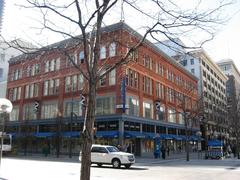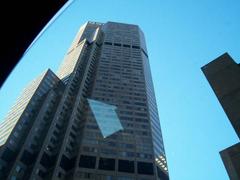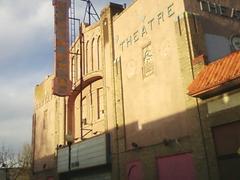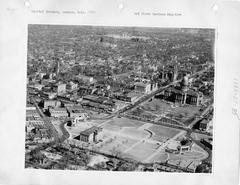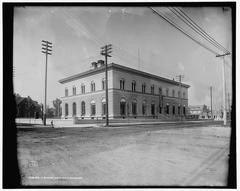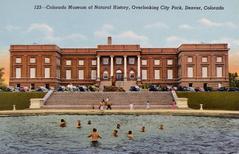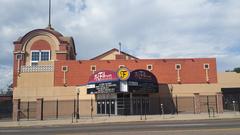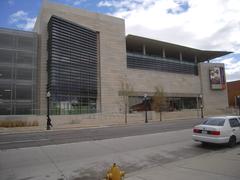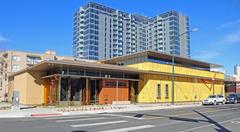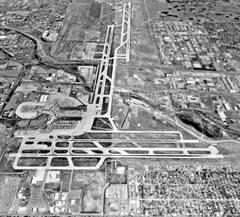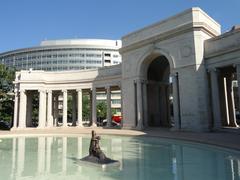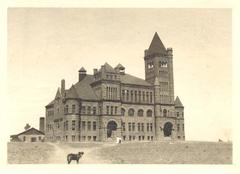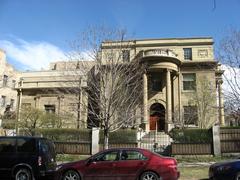Southmoor Park Denver: Visiting Hours, Tickets, and Attractions Guide
Date: 14/06/2025
Introduction to Southmoor Park: History and Cultural Significance
Southmoor Park, located in southeast Denver, Colorado, is both a vibrant residential neighborhood and a cherished public green space. Developed in the post-World War II era, the neighborhood was designed as a family-oriented enclave, featuring ranch-style homes, mature tree-lined streets, and a strong emphasis on outdoor living. Its prime location adjacent to Interstate 25 and proximity to the Southmoor light rail station provides easy access to downtown Denver and the Denver Tech Center, blending suburban tranquility with urban convenience (UrbanSol Collective; 5280 Magazine; Denverite).
The heart of the neighborhood is Southmoor Park itself, an 11-acre urban park renowned for its well-maintained playgrounds, sports courts, picnic areas, and paved trails. The park is open daily from dawn to dusk (typically 5:00 AM to 11:00 PM) and is free to the public, offering ample parking and convenient transit options (Denver Parks & Recreation). The area also features nearby parks, access to the High Line Canal Trail, and easy trips to Cherry Creek State Park, fostering a culture of active living and community engagement.
Southmoor Park stands as a testament to Denver’s evolution—balancing preservation of its suburban character with ongoing modernization. Residents have played an active role in shaping local development, ensuring the neighborhood retains its unique identity within the broader city landscape (Denverite; 5280 Magazine).
Table of Contents
- Introduction
- Early Origins and Development
- Community Identity and Suburban Character
- Visiting Southmoor Park: Hours, Amenities, and Accessibility
- Transportation and Urban Connectivity
- Nearby Attractions and Travel Tips
- Community Activism and Development Control
- Recent Transformations and Ongoing Debates
- Significance Within Denver
- Frequently Asked Questions (FAQ)
- Visuals and Media Recommendations
- Related Articles
- Conclusion and Call to Action
Early Origins and Development
Southmoor Park’s origins date to the post-WWII suburban expansion of Denver, with the first homes built in the early 1960s. The neighborhood is defined by boundaries stretching from Hampden Avenue (north) to Belleview Avenue (south), and from Happy Canyon/Dahlia (west) to Tamarac (east) (UrbanSol Collective). The initial development phase focused on spacious ranch-style homes with large yards and mature landscaping, catering to families seeking a peaceful environment within city limits (5280 Magazine).
Over time, Southmoor Park diversified its housing stock, introducing townhomes and apartments to meet the evolving needs of professionals and younger families. The neighborhood’s strategic location near major highways and the light rail system facilitated steady growth and accessibility.
Community Identity and Suburban Character
Southmoor Park was envisioned as a tranquil, family-oriented community. Its layout emphasizes walkability, green spaces, and convenient access to amenities. The central park area features playgrounds, sports fields, picnic spots, and paved trails, cementing its role as a neighborhood gathering place (Snoflo; MyPacer). Commercial development in the area, including Tiffany Plaza and other shopping centers, further enhances self-sufficiency and convenience (UrbanSol Collective).
Visiting Southmoor Park: Hours, Amenities, and Accessibility
Park Hours and Admission
- Hours: Open daily from 5:00 AM to 11:00 PM.
- Admission: Free. No tickets required.
Amenities
- Playground: Modern, safe play structures for children.
- Sports Facilities: Basketball and tennis courts, multi-use sports fields.
- Picnic Areas: Shaded sites with tables and grills.
- Walking Paths: ADA-compliant, wheelchair-accessible paved trails.
- Open Lawns: Expansive grassy areas for recreation and relaxation.
Parking and Accessibility
- Parking: Ample free street and on-site parking, including accessible spaces.
- Transit: The Southmoor light rail station offers convenient public transit options, though pedestrian access from the west side of I-25 is limited (Denverite).
- Accessibility: ADA-compliant paths and playground equipment, accessible restrooms (seasonal availability).
Pets and Rules
- Dogs are welcome but must be kept on a leash.
- Owners must clean up after pets.
- Smoking and alcohol are generally restricted in accordance with Denver’s park policies.
Transportation and Urban Connectivity
Southmoor Park’s location ensures excellent connectivity via car, bike, and public transit. The neighborhood is bordered by major roadways and served by Denver RTD’s light rail and bus lines, making it easy to reach downtown, the Denver Tech Center, and other city destinations (Denverite; Denver RTD). Community efforts to maintain a suburban character have influenced transit station design and limited high-density development near transit nodes.
Nearby Attractions and Travel Tips
- Cherry Creek State Park: Just 10 minutes away, offering hiking, boating, and wildlife viewing.
- Denver Tech Center: A nearby business hub with shopping, dining, and entertainment.
- High Line Canal Trail: Scenic multi-use trail accessible from the neighborhood.
- Local Dining: Enjoy diverse culinary options in surrounding shopping centers.
- Travel Tips: Use public transit to avoid parking congestion, check event calendars, and bring water and sun protection during summer months (Make Time to See the World).
Community Activism and Development Control
Southmoor Park is notable for strong community engagement in land use decisions. Since the 1980s, residents have organized through homeowners’ associations and a Registered Neighborhood Organization to limit high-density projects and preserve the area’s suburban character. Legal agreements and advocacy have shaped both the built environment and the pace of redevelopment (Denverite).
Recent Transformations and Ongoing Debates
Recent years have brought renewed discussions about redevelopment, particularly around the light rail station. While city planners envision transit-oriented, mixed-use development, high land costs and local resistance have limited large-scale changes. Projects like the addition of a freestanding emergency room and new apartments reflect incremental transformation, but debates over the neighborhood’s future continue (Denverite).
Significance Within Denver
Southmoor Park exemplifies the tensions and possibilities of Denver’s urban evolution. The neighborhood is affluent, with average home sale prices exceeding $2.3 million in 2024 (5280 Magazine). Its parks, schools, and transportation links make it a desirable place to live, while ongoing debates about density and modernization reflect broader citywide trends (UrbanSol Collective).
Frequently Asked Questions (FAQ)
What are Southmoor Park’s visiting hours?
Open daily from 5:00 AM to 11:00 PM.
Is there parking available?
Yes, ample free parking is available on-site and on surrounding streets.
Are pets allowed?
Yes, leashed dogs are welcome. Owners must clean up after pets.
What activities can I enjoy at Southmoor Park?
Play on modern playgrounds, use sports courts and fields, picnic, walk or jog on paved paths, and relax on open lawns.
Are there any special events?
Community events are held seasonally. Check the Denver Parks & Recreation website for updates.
Visuals and Media Recommendations
For an enhanced experience, explore high-quality images of Southmoor Park’s playgrounds, trails, and green spaces. Downloadable or interactive maps can help you navigate the park and surrounding neighborhood.
Related Articles
Residential Character and Community Structure
Southmoor Park comprises around 160 homes, with a population of about 6,050 and a median age of 34—resulting in a vibrant mix of families, singles, and retirees. The Registered Neighborhood Organization (RNO) fosters community engagement, safety, and regular events (Southmoor Park HOA; Denver Group RE).
Parks, Trails, and Outdoor Recreation
The neighborhood offers several pocket parks and access to the High Line Canal Trail, providing ample space for walking, jogging, cycling, and community gatherings (Southmoor Park HOA).
Shopping, Dining, and Local Services
While primarily residential, Southmoor Park’s central location means shopping, dining, and services are easily accessible at nearby commercial centers and in the Denver Tech Center (Denver Group RE; Secret Denver).
Community Events and Social Life
The RNO organizes seasonal events and informal meetups, promoting a strong sense of community. The neighborhood’s proximity to major city festivals and events enriches social life (Thrillist).
Education and Safety
Southmoor Park is served by reputable schools and maintains a low crime rate, supported by active neighborhood advocacy and collaboration with city officials (Denver Group RE; Southmoor Park HOA).
Practical Tips for Visitors
- Use public transit or bike-sharing for easy access.
- Dress in layers and be prepared for rapid weather changes (Lonely Planet).
- Acclimate to Denver’s altitude by staying hydrated.
- Check for seasonal community events during your visit (Secret Denver).
Summary and Call to Action
Southmoor Park Denver seamlessly blends historical charm, modern amenities, and a vibrant community spirit. With its accessible parks, strong transportation links, and active resident involvement, it stands out as a model neighborhood in the Mile High City. For the best experience, use public transit, check event calendars, and explore local dining and shopping options. Stay informed by visiting official Denver Parks resources and downloading the Audiala app for real-time updates.
References and Further Reading
- UrbanSol Collective
- 5280 Magazine
- Denverite
- Denver Parks & Recreation
- Southmoor Park HOA
- Denver Group RE
- Snoflo
- MyPacer
- Denver Free Walking Tours
- Denver RTD
- Eternal Arrival
- Make Time to See the World
- Denver Parks Dog Policy
- Denver Parks Safety
- Secret Denver
- Thrillist
- Lonely Planet
